paper no: nano2
last update: 11/05/08
NANO ROBTICS
Introduction to Nanotechnology:
Nanotechnology can best be considered as a 'catch-all' description of activities at the level of atoms and molecules that have applications in the real world. A nanometer is a billionth of a meter, that is, about 1/80,000 of the diameter of a human hair, or 10 times the diameter of a hydrogen atom.
An early promoter of the industrial applications of Nanotechnology, Albert Franks, defined it as 'that area of science and technology where dimensions and tolerances in the range of 0.1nm to 100 nm play a critical role' . It encompasses precision engineering as well as electronics; electromechanical systems (e.g. 'lab-on-a-chip' devices) as well as mainstream biomedical applications in areas as diverse as gene therapy, drug delivery and novel drug discovery techniques.
The prefix nano is used to denote one billionth (1nm=10^-9) m). In present context, it has come to mean anything much smaller than our current standard capability. At the simplest level, Nanotechnology is the manipulation of single atoms and molecules to create objects that can be smaller than 100 nanometers. Important changes in behavior are caused not by the order of magnitude size reduction, but also by new phenomena, quantum mechanics and Coulomb blockade. It is notable that all relevant phenomena at nano-scale are caused by the tiny size of the organized structure as compared to molecular scale, and by the interactions at their predominant and complex interfaces.
Nanotechnology is ability to do things-measure, see, predict and make-on the scale of atoms and molecules.
Nanotechnology is rapidly becoming the Industrial Revolution of the 21st Century. The nanotech industry today might be compared to the computer industries of 1960s, before the development of the integrated circuit, or the bio-tech industries of 1970s.
WHY NANOTECHNOLOGY?
Every living thing is made of cells that are chock-full of nano-machines-proteins, DNA, RNA, etc.-each jiggling around in the water of the cell, rubbing up against molecules, going about the business of life. Each one is perfect right down to the last atom. The workings are so exquisite that changing the location or identity of any atom would cause damage. Over the past century, scientists have learned about the workings of these biological nano-machines to an incredible level of detail, and the benefits of this knowledge are beginning to be felt in medicine. In coming decades,
we will learn to modify and adapt this machinery to extend the quality and length of life. Bio-technology was the first Nanotechnology, and it has a long way yet to go.
Twenty years ago, without even this crude chemotherapy any cancer patient would already be dead. But twenty years from now nano-technology will have given us specially engineered drugs which are nanoscale cancer-seeking missiles, a molecular technology that specifically targets just the mutant cancer cells in the human body, and leaves everything else blissfully alone. To do this, these drug molecules will have to be big enough-thousands of atoms-so that we can code the information into them of where they should go and what they should kill. They will be examples of an exquisite, human-made nanotechnology of the future. This is what the requirement of time now, and the challenge in front of an engg in this century.
Nanotechnology is an umbrella term that covers many areas of research dealing with objects that are measured in nanometers. A nanometer (nm) is a billionth of a meter, or a millionth of a millimeter.
Thought of Nano-robotics:
Nanorobotics deals with the controlled manipulation of objects with nanometer-scale dimensions. As an atom has a diameter of a few Ångstroms (1 Å = 0.1 nm = 10-10 m), and a molecule´s size is a few nanometers.
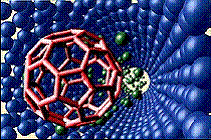
Nanorobotics is concerned with interactions with atomic- and molecular-sized objects, and is sometimes called molecular robotics.
The fact that enormous amounts of information can be carried in an exceedingly small space ,because in the tiniest cell, all of the information for the organization of a complex creature such as humans can be stored.
Many of the cells are very tiny, but they are very active; they manufacture various substances, they walk around, they wiggle; and they do all kinds of marvelous things - all on a very small scale. Also, they store information. This thought lead to the launching of nanorobotics.
Medical nanotechnology is often expected to utilize nanorobots injected into the patient to perform their treatment on a cellular level. Instead, medical nanorobots may be manufactured in carefully controlled nanofactories in which nanoscale machines are solidly integrated into a desktop-scale machine that builds macroscopic products
Nanorobotic Technology:
Nanorobotics, an emerging field in medicine which states that nanorobots travel inside our bodies, digging for information, finding defects or delivering drugs. Basically, we may observe two distinct kind of nanorobot utilization. One is nanorobots for the surgery intervention, and the other is nanorobot to monitor patients' body. For the first case, a most suitable approach is the tele-operation of nanorobots as valuable tools for biomedical engineering problems. Hence, for example surgery experts guiding a minimally invasive medical procedure. For cases such as monitoring the human body, the nanorobots are expected to follow a defined set of specified activation rules for triggers of designed behaviors. In such case the nanorobot is designed to be able to interact with the 3D human body environment, in order to fulfil programmed tasks.
The nanorobots require specific controls, sensors and actuators, basically in accordance with each kind of biomedical application. Sensors may be wireless ultra fast, super sensitive, and non-invasive and may use chemical, electronic or photonic based detection
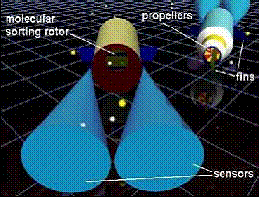 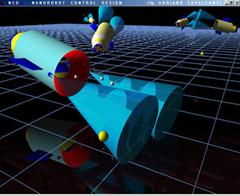
Nanorobot 3D design and Nanorobots identifying molecules through their sensors .
The depicted bluecones shows the sensors “touching” areas that triggers the nanorobots' behaviors. Computational nanoborotics approaches are being explored successfully in nanoscience and nanotechnology research, to provide researchers with an intuitive way to interact with materials and devices at the nanoscale. Virtual-environment interface to Scanning Probe Microscopes (SPMs) have been provided, giving a virtual telepresence on the surface but downscaled by a factor of about a million to one. The introduction of direct human-SPM interaction creates not only enhanced measurement capability, but also presages a more interactive technology that will enable easy nanofabrication and/or repair of nanostructures. Nanoscale object manipulation systems have been applied with the use of computer graphics for teleoperation, where the requirements for such systems have been clearly established.
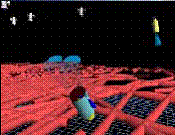
Sensing obstacles
Applying a simulator help us for a better insight on many reactions, considering nanorobots collective work coordination, energy consumption, and control automation. The Nanorobot Control Design (NCD) can be a big plus for robots experts and control engineers regarding good choices on the better way to apply and operate nanorobots. Developing nanoscale robots presents difficult fabrication and control challenges.
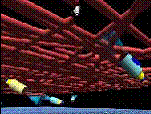
Nanorobot obstacle avoidance
Nano-robots Inside Our Bodies: Among biomedical problems, monitoring nutrient concentrations into the human body is a possible application of nanorobots in medicine. Nanorobots might be used as well to seek and break kidney stones.One interesting nanorobot utilization is also to assist inflammatory cells (or white cells) in leaving blood vessels to repair injured tissues.
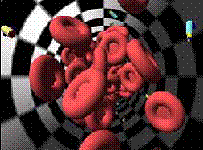
Red blood cells and nanorobots inside a blood vessel
View of simulator workspace showing the vessel wall with a grid texture, cells and nanorobots. They are medical surgeons that find damaged cells and repair them. Using nanorobotics, doctors could create robots called nanites that travel through the human bloodstream, firing ' medicinetorpedoes ' at diseased cells, while leaving healthy cells intact.These smaller robots are able to repair and monitor intracellular structures like DNA. Nanorobots can alter DNA to reduce the number of hereditary diseases and defects in a person . The scanning tunneling microscope has allowed scientists to devise intelligent artificial antibodies, red and white blood cells and antiviral medication.
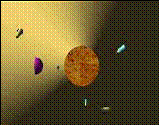
Blood vessel inside view.
For Further more download pdf...
|